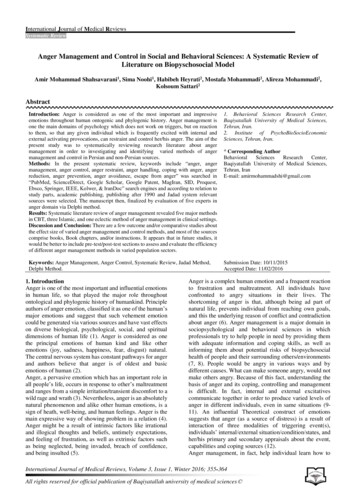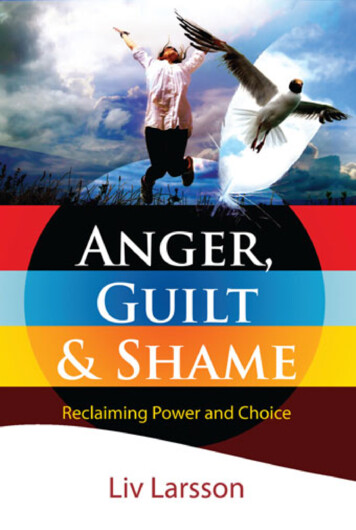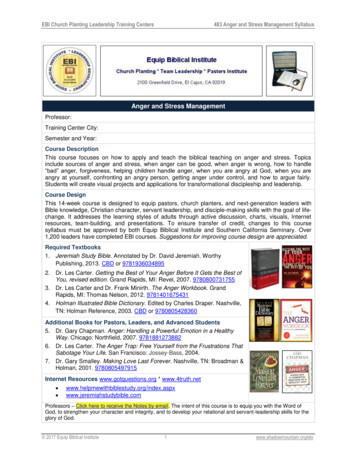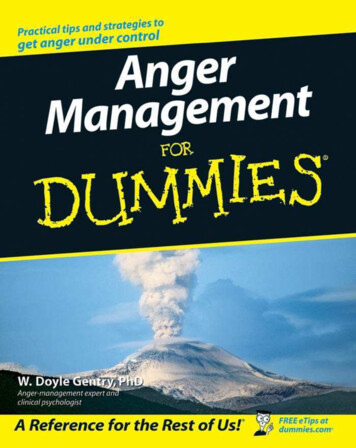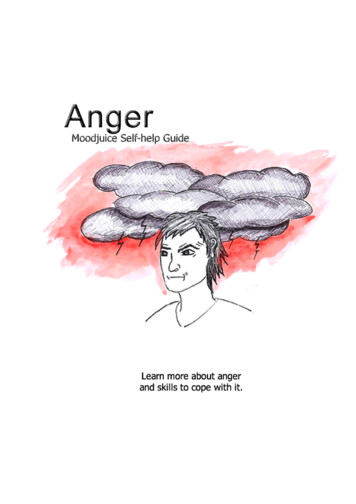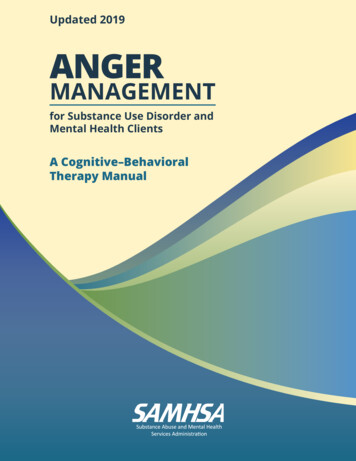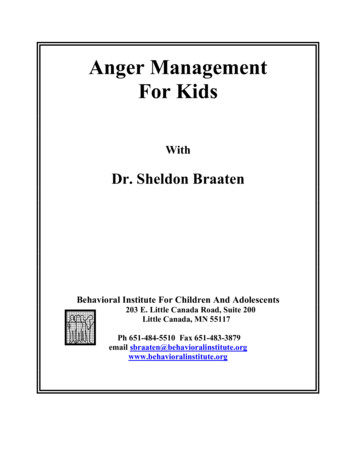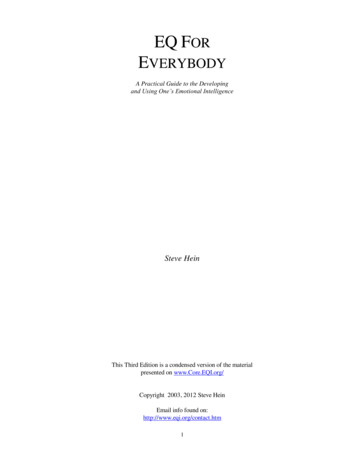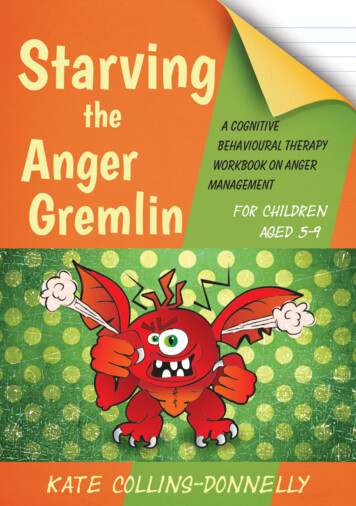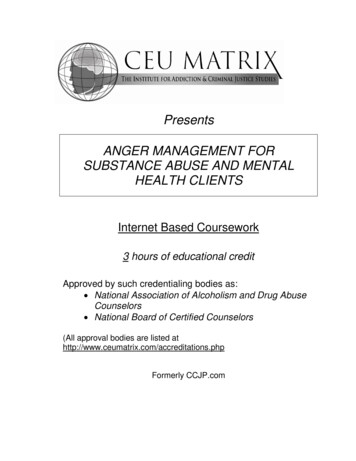
Transcription
PresentsANGER MANAGEMENT FORSUBSTANCE ABUSE AND MENTALHEALTH CLIENTSInternet Based Coursework3 hours of educational creditApproved by such credentialing bodies as: National Association of Alcoholism and Drug AbuseCounselors National Board of Certified Counselors(All approval bodies are listed rly CCJP.com
Anger Management for Substance Abuse andMental Health ClientsWelcome to the growing family of coursework participants at CEU Matrix - TheInstitute for Addiction and Criminal Justice Studies.This distance learning course package was developed for CEU Matrix by RobertShearer, Ph.D. It is based on information found in the Reilly PM and ShopshireMS. Anger Management for Substance Abuse and Mental Health Clients: ACognitive Behavioral Therapy Manual. DHHS Pub. No. (SMA) 08-4213.Rockville, MD: Center for Substance Abuse Treatment, Substance Abuse andMental Health Services Administration, 2002, reprinted 2003, 2005, 2006, 2007,and 2008.Copies may be obtained free of charge from SAMHSA's National Clearinghousefor Alcohol and Drug Information (NCADI), (800) 729-6686 or (301) 468-2600;TDD (for hearing impaired), (800) 487-4889; or electronically through thefollowing Web site: www.ncadi.samhsa.gov.This package contains the complete set of SAMHSA course materials, along withthe post test and evaluation that are required to obtain the certificate ofcompletion for the course. You may submit your answers online to receive thefastest response and access to your online certificate of completion. To takeadvantage of this option, simply access the Student Center athttp://www.ceumatrix.com/studentcenter; login as a Returning Customer byentering your email address, password, and click on 'Take Exam'. For yourconvenience, we have also enclosed an answer sheet that will allow you tosubmit your answers by mail or by fax.Copyright NoticeThe documents and information on this Web site excluding the SAMHSAmaterials are copyrighted materials of CEUMatrix, LLC, and its informationproviders. Reproduction or storage of materials retrieved from this service issubject to the U.S. Copyright Act of 1976, Title 17 U.S.C. Copyright 2010 CEU Matrix, LLC.All rights reserved. Do not duplicate or redistribute in any form. Printed in theUnited States of America. No portion of this publication may be reproduced inany manner without the written permission of the publisher.
About the Instructor:Dr. Robert A. Shearer is a retired professor of Criminal Justice, Sam HoustonState University. He received his Ph.D. in Counseling and Psychology fromTexas A & M University, Commerce. Prior to teaching Criminal Justice, hetaught Educational Psychology at Mississippi State University on campus and inthe extension program across rural Mississippi during the civil rights era.He has been teaching, training, consulting and conducting research in the fieldsof Criminal Justice, human behavior, and addictions for over thirty-six years. Heis the author of over sixty professional and refereed articles in Criminal Justiceand behavior. He is also the author of Interviewing: Theories, Techniques, andPractices, 5th edition published by Prentice Hall. Dr. Shearer has also createdover a dozen measurement, research, and assessment instruments in CriminalJustice and addictions.He has been a psychotherapist in private practice and served as a consultant todozens of local, state, and national agencies. His interests continue to besubstance abuse program assessment and evaluation. He has taught courses ininterviewing, human behavior, substance abuse counseling, drugs-crime-socialpolicy, assessment and treatment planning, and educational psychology. He hasalso taught several university level psychology courses in the Texas Departmentof Criminal Justice Institutional Division, led group therapy in prison, trainedgroup therapists, and served as an expert witness in various courts of law.He has been the president of the International Association of Addictions andOffender Counseling and the editor of the Journal of Addictions and OffenderCounseling as well as a member of many Criminal Justice, criminology, andcounseling professional organizations prior to retirement.Using the Homepage for CEU Matrix - The Institutefor Addiction and Criminal Justice StudiesThe CEU Matrix – The Institute for Addiction and Criminal Justice Studieshomepage (www.ceumatrix.com) contains many pieces of information andvaluable links to a variety of programs, news and research findings, andinformation about credentialing – both local and national. We update our site ona regular basis to keep you apprised of any changes or developments in the fieldof addiction counseling and credentialing. Be sure to visit our site regularly, andwe do recommend that you bookmark the site for fast and easy return.
Anger Management for Substance Abuse andMental Health ClientsCourse Summary and GoalsCourse Summary:Substance use and abuse often coexist with anger and violence. Thiscourse is designed to introduce students to a manual that was developedfor use by qualified substance abuse counselors who work with substanceabuse and mental health clients with concurrent anger problems.The treatment model described in the manual consists of a combined CBTapproach that employs relaxation, cognitive, and communication skillsinterventions. The effectiveness of the manual is supported by extensiveresearch studies that show significant decreased levels of anger.Course Goals/objectives:Upon completion of this course the student will be able to: Understand how to deliver group cognitive behavioral angermanagement treatment to clients with substance abuse and mentalhealth disorders.Understand the purpose of an anger management group.Understand group rulesUnderstand the problem of angerIdentify myths about angerUnderstand the anger habitIdentify how to break the anger habitUnderstand how to construct an anger meterIdentify the events that trigger angerUnderstand the cues to angerIdentify how to construct an anger control planUnderstand the aggression cycleUnderstand the A-B-C-D modelUnderstand thought stoppingUnderstand assertiveness trainingIdentify the conflict resolution modelUnderstand anger and the family
Anger Managementfor Substance Abuse andMental Health ClientsA Cognitive Behavioral Therapy ManualPatrick M. Reilly, Ph.D.Michael S. Shopshire, Ph.D.U.S. DEPARTMENT OF HEALTH AND HUMAN SERVICESSubstance Abuse and Mental Health Services AdministrationCenter for Substance Abuse Treatment1 Choke Cherry RoadRockville, MD 20857
Anger Managementfor Substance Abuse and Mental Health ClientsAcknowledgmentsNumerous people contributed to the development of this manual (see appendix). The docu ment was written by Patrick M. Reilly, Ph.D., and Michael S. Shopshire, Ph.D., of the SanFrancisco Treatment Research Center. Sharon Hall, Ph.D., was the Treatment ResearchCenter’s Principal Investigator.DisclaimerThis document is, in part, a product of research conducted with support from the NationalInstitute on Drug Abuse, Grant DA 09253, and the Department of Veterans Affairs to the SanFrancisco VA Medical Center, San Francisco Treatment Research Center, Department ofPsychiatry, University of California, San Francisco. The document was produced by Johnson,Bassin & Shaw, Inc., under Contract No. 270-99-7072 with the Substance Abuse and MentalHealth Services Administration (SAMHSA), U.S. Department of Health and Human Services(DHHS). Karl White, Ed.D., served as the Center for Substance Abuse Treatment (CSAT)Knowledge Application Program (KAP) Project Officer. The content of this publication does notnecessarily reflect the views or policies of CSAT, SAMHSA, or DHHS.Public Domain NoticeAll material appearing in this report is in the public domain and may be reproduced or copiedwithout permission from SAMHSA or CSAT. Citation of the source is appreciated. However, thispublication may not be reproduced or distributed for a fee without the specific, written authori zation of the Office of Communications, SAMHSA, DHHS.Electronic Access and Copies of PublicationThis publication can be accessed electronically through the following Internet World Wide Webconnection: www.kap.samhsa.gov. For additional free copies of this document, please callSAMHSA’s National Clearinghouse for Alcohol and Drug Information at 1-800-729-6686or 1-800-487-4889 (TDD).Recommended CitationReilly PM and Shopshire MS. Anger Management for Substance Abuse and Mental HealthClients: A Cognitive Behavioral Therapy Manual. DHHS Pub. No. (SMA) 08-4213. Rockville, MD:Center for Substance Abuse Treatment, Substance Abuse and Mental Health ServicesAdministration, 2002, reprinted 2003, 2005, 2006, 2007, and 2008.Originating OfficeQuality Improvement and Workforce Development Branch, Division of Services Improvement,Center for Substance Abuse Treatment, Substance Abuse and Mental Health ServicesAdministration, 1 Choke Cherry Road, Rockville, MD 20857.DHHS Publication No. (SMA) 08-4213Printed 2002Reprinted 2003, 2005, 2006, 2007, and 2008
ForewordSubstance use and abuse often coexist with anger and violence. Data from the SubstanceAbuse and Mental Health Services Administration’s National Household Survey on Drug Abuse,for example, indicated that 40 percent of frequent cocaine users reported engaging in someform of violent behavior. Anger and violence often can have a causal role in the initiation ofdrug and alcohol use and can also be a consequence associated with substance abuse.Individuals who experience traumatic events, for example, often experience anger and act vio lently, as well as abuse drugs or alcohol.Clinicians often see how anger and violence and substance use are linked.Many substance abuse and mental health clients are victims of traumatic life events, which,in turn, lead to substance use, anger, and violence.Despite the connection of anger and violence to substance abuse, few treatments have beendeveloped to address anger and violence problems among people who abuse substances.Clinicians have found the dearth of treatment approaches for this important issue disheartening.To provide clinicians with tools to help deal with this important issue, the Center for SubstanceAbuse Treatment of the Substance Abuse and Mental Health Services Administration ispleased to present Anger Management for Substance Abuse and Mental Health Clients:A Cognitive Behavioral Therapy Manual and its companion book Anger Management forSubstance Abuse and Mental Health Clients: Participant Workbook.The anger management treatment design in this manual, which has been delivered to hun dreds of clients over the past 8 years, has been popular with both clinicians and clients. Thistreatment design can be used in a variety of clinical settings and will be beneficial to the field.Terry L. Cline, Ph.D.AdministratorSubstance Abuse and Mental Health Services AdministrationH. Westley Clark, M.D., J.D., M.P.H., CAS, FASAMDirectorCenter for Substance Abuse TreatmentWashington, D.C.iii
ContentsForeword . . . . . . . . . . . . . . . . . . . . . . . . . . . . . . . . . . . . . . . . . . . . . . . . . . . . . . . . . . . . . . . . . . . . . . iiiIntroduction. . . . . . . . . . . . . . . . . . . . . . . . . . . . . . . . . . . . . . . . . . . . . . . . . . . . . . . . . . . . . . . . . . . . 1How To Use This Manual . . . . . . . . . . . . . . . . . . . . . . . . . . . . . . . . . . . . . . . . . . . . . . . . . . . . . . . . . 5Session 1Overview of Group Anger Management Treatment. . . . . . . . . . . . . . . . . . . . 7Session 2Events and Cues: A Conceptual Framework forUnderstanding Anger . . . . . . . . . . . . . . . . . . . . . . . . . . . . . . . . . . . . . . . . . . 15Session 3Anger Control Plans: Helping Group Members Develop aPlan for Controlling Anger . . . . . . . . . . . . . . . . . . . . . . . . . . . . . . . . . . . . . . . 21Session 4The Aggression Cycle: How To Change the Cycle . . . . . . . . . . . . . . . . . . . . 27Session 5Cognitive Restructuring: The A-B-C-D Model and Thought Stopping. . . . . 33Session 6Review Session #1: Reinforcing Learned Concepts . . . . . . . . . . . . . . . . . . 37Sessions 7 & 8Assertiveness Training and the Conflict Resolution Model:Alternatives for Expressing Anger . . . . . . . . . . . . . . . . . . . . . . . . . . . . . . . . 39Sessions 9 & 10Anger and the Family: How Past Learning CanInfluence Present Behavior . . . . . . . . . . . . . . . . . . . . . . . . . . . . . . . . . . . . . 45Session 11Review Session #2: Reinforcing Learned Concepts . . . . . . . . . . . . . . . . . . 49Session 12Closing and Graduation: Closing Exercise andAwarding of Certificates . . . . . . . . . . . . . . . . . . . . . . . . . . . . . . . . . . . . . . . . 51References . . . . . . . . . . . . . . . . . . . . . . . . . . . . . . . . . . . . . . . . . . . . . . . . . . . . . . . . . . . . . . . . . . . 53Appendix: Authors’ Acknowledgments . . . . . . . . . . . . . . . . . . . . . . . . . . . . . . . . . . . . . . . . . . . . . 57v
IntroductionThis manual was designed for use by qualified substance abuse and mental health clinicianswho work with substance abuse and mental health clients with concurrent anger problems.The manual describes a 12-week cognitive behavioral anger management group treatment.Each of the 12 90-minute weekly sessions is described in detail with specific instructions forgroup leaders, tables and figures that illustrate the key conceptual components of the treat ment, and homework assignments for the group participants. An accompanying ParticipantWorkbook is available (see Anger Management for Substance Abuse and Mental HealthClients: Participant Workbook, Reilly, Shopshire, Durazzo, & Campbell, 2002) and should beused in conjunction with this manual to enable the participants to better learn, practice, andintegrate the treatment strategies presented in the group sessions. This intervention was devel oped for studies at the San Francisco Veterans Affairs (SFVA) Medical Center and SanFrancisco General Hospital.Cognitive behavioral therapy (CBT) treatments have been found to be effective, time-limitedtreatments for anger problems (Beck & Fernandez, 1998; Deffenbacher, 1996; Trafate, 1995).Four types of CBT interventions, theoretically unified by principles of social learning theory, aremost often used when treating anger disorders: Relaxation interventions, which target emotional and physiological components of anger Cognitive interventions, which target cognitive processes such as hostile appraisals andattributions, irrational beliefs, and inflammatory thinking Communication skills interventions, which target deficits in assertiveness and conflict reso lution skills Combined interventions, which integrate two or more CBT interventions and target multipleresponse domains (Deffenbacher, 1996, 1999).Meta-analysis studies (Beck & Fernandez, 1998; Edmondson & Conger, 1996; Trafate, 1995)conclude that there are moderate anger reduction effects for CBT interventions, with averageeffect sizes ranging from 0.7 to 1.2 (Deffenbacher, 1999). From these studies, it can beinferred that the average participant under CBT conditions fared better than 76 percent of con trol participants. These results are consistent with other meta-analysis studies examining theeffectiveness of CBT interventions in the treatment of depression (Dobson, 1989) and anxiety(Van Balkom et al., 1994).The treatment model described in this manual is a combined CBT approach that employs relax ation, cognitive, and communication skills interventions.1
Anger Managementfor Substance Abuse and Mental Health ClientsThis combined approach presents the participants with options that draw on these differentinterventions and then encourages them to develop individualized anger control plans using asmany of the techniques as possible. Not all the participants use all the techniques and inter ventions presented in the treatment (e.g., cognitive restructuring), but almost all finish thetreatment with more than one technique or intervention on their anger control plans.Theoretically, the more techniques and interventions an individual has on his or her angercontrol plan, the better equipped he or she will be to manage anger in response to angerprovoking events.In studies at the SFVA Medical Center and San Francisco General Hospital using this treatmentmodel, significant reductions in self-reported anger and violence have consistently been found,as well as decreased substance use (Reilly, Clark, Shopshire, & Delucchi, 1995; Reilly,Shopshire, & Clark, 1999; Reilly & Shopshire, 2000; Shopshire, Reilly, & Ouaou, 1996). Mostparticipants in these studies met Diagnostic and Statistical Manual of Mental Disorders, 4thEdition (DSM-IV) (American Psychiatric Association, 1994) criteria for substance dependence,and many also met DSM-IV criteria for posttraumatic stress disorder. A study comparingCaucasian and African-American patients found that patients from both groups reduced theiranger significantly (Clark, Reilly, Shopshire, & Campbell, 1996). Another study showed thatwomen also benefited from the intervention—that is, reported decreased levels of anger (Reillyet al., 1996).In the anger management studies using this manual, the majority of patients were from ethnicminority groups. Consistent reductions in anger and aggressive behavior occurred in thesegroups, indicating that anger management group treatment is effective. The treatment modelis flexible and can accommodate racial, cultural, and gender issues. The events or situationsthat trigger someone’s anger may vary somewhat depending on his or her culture or gender.The cues or warning signs of anger may vary in this regard as well. Nevertheless, the overalltreatment model still applies and was found effective with different ethnic groups and withboth men and women. A person still has to identify the triggering event, recognize the cues toanger, and develop anger management (cognitive behavioral) strategies in response to theevent and cues, regardless of whether these events and cues are different for other men andwomen or for people in other cultural groups.The intervention involves developing individualized anger control plans. For example, somewomen identified their relationships with their boyfriends or partners or parenting concerns asevents that triggered their anger but men rarely identified these issues. Effective individualstrategies could be developed, however, to address these issues, provided the women acceptthe concepts of monitoring anger (using the anger meter) and having (and using) an anger con trol plan.This treatment model was also used successfully with non–substance-abusing clients seen inthe outpatient SFVA Mental Health Clinic. These clients were diagnosed with a variety of prob lems, including mood, anxiety, and thought disorders. The treatment components described inthis manual served as the core treatment in these studies.2
A Cognitive Behavioral Therapy ManualThe anger management treatment should be delivered in a group setting. The ideal number ofparticipants in a group is 8, but groups can range from 5 to 10 members. There are severalreasons for this recommendation. First, solid empirical support exists for group cognitivebehavioral interventions (Carroll, Rounsaville, & Gawin, 1991; Maude-Griffin et al., 1998;Smokowski & Wodarski, 1996); second, group treatment is efficient and cost-effective (Hoyt,1993; Piper & Joyce, 1996); and third, it provides a greater range of possibilities and flexibilityin roleplays (Yalom, 1995) and behavioral rehearsal activities (Heimberg & Juster, 1994; Juster& Heimberg, 1995). Counselors and social workers should have training in cognitive behavioraltherapy, group therapy, and substance abuse treatment (preferably, at the master’s level orhigher; doctoral-level psychologists have delivered the anger management treatment as well).Although a group format is recommended for the anger management treatment, it is possiblefor qualified clinicians to use this manual in individual sessions with their clients. In this case,the same treatment format and sequence can be used. Individual sessions provide more timefor in-depth instruction and individualized behavioral rehearsal.The anger management treatment manual is designed for adult male and female substanceabuse and mental health clients (age 18 years and above). The groups studied at SFVAMedical Center and San Francisco General Hospital have included patients who have usedmany substances (e.g., cocaine, alcohol, heroin, methamphetamine). These patients have beenable to use the anger management materials and benefit from the group treatment despite dif ferences in their primary drug of abuse.It is recommended that participants be abstinent from drugs and alcohol for at least 2 weeksprior to joining the anger management group. If a participant had a “slip” during his or herenrollment in the group, he or she was not discharged from the group. However, if he or shehad repeated slips or a full-blown relapse, the individual was referred to a more intensifiedtreatment setting and asked to start the anger management treatment again.Many group participants were diagnosed with co-occurring disorders (e.g., posttraumatic stressdisorder [PTSD], mood disorder, psychosis) but benefited from the anger management grouptreatment. Patients were compliant with their psychiatric medication regimen and were moni tored by interdisciplinary treatment teams. The San Francisco group found that, if patientswere compliant with their medication regimen and abstinent from drugs and alcohol, theycould comprehend the treatment material and effectively use concepts such as timeouts andthought stopping to manage anger. However, if a participant had a history of severe mental ill ness, did not comply with instructions on his or her psychiatric medication regimen, and haddifficulty processing the material or accepting group feedback, he or she was referred to his orher psychiatrist for better medication management.Several practitioners have requested the manual to work with adolescent clients in substanceabuse treatment, but no preliminary data from these treatment encounters are available.Because of the many problems often experienced by substance abuse and mental healthclients, this intervention should be used as an adjunctive treatment to substance abuse and3
Anger Managementfor Substance Abuse and Mental Health Clientsmental health treatment. Certain issues, such as anger related to clients’ family of origin andpast learning, for example, may best be explored in individual and group therapy outside theanger management group.Finally, the authors stress the importance of providing ongoing anger management aftercaregroups. Participants at the SFVA Medical Center repeatedly asked to attend aftercare groupswhere they could continue to practice and integrate the anger management strategies theylearned in this treatment. At the SFVA Medical Center, both an ongoing drop-in group and amore structured 12-week phase-two group were provided as aftercare components. Thesegroups help participants maintain (and further reduce) the decreased level of anger andaggression they achieved during the initial 12-week anger management group treatment.Participants can also be referred to anger management groups in the community.It is hoped that this anger management manual will help substance abuse and mental healthclinicians provide effective anger management treatment to clients who experience anger prob lems. Reductions in frequent and intense anger and its destructive consequences can lead toimproved physical and mental health of individuals and families.4
How To Use This ManualThe information presented in this manual is intended to allow qualified mental health and sub stance abuse professionals to deliver group cognitive behavioral anger management treatmentto clients with substance abuse and mental health disorders. Each of the 12 90-minute weeklysessions is divided into four sections: Instructions to Group Leaders Check-In Procedure (beginning in the second session) Suggested Remarks Homework Assignments.The Instructions to Group Leaders section summarizes the information to be presented in thesession and outlines the key conceptual components. The Check-In Procedure section providesa structured process by which group members check in at each session and report on theprogress of their homework assignments from the previous week. The Suggested Remarks sec tion provides narrative scripts for the group leader presenting the material in the session.Although the group leader is not required to read the scripts verbatim, the group leader shoulddeliver the information as closely as possible to the way it is in the script. The HomeworkAssignment section provides instructions for group members on what tasks to review and prac tice for the next meeting. Session 1 also includes a special section that provides an overviewof the anger management treatment and outlines the group rules.This manual should be used in conjunction with the Anger Management for Substance Abuseand Mental Health Clients: Participant Workbook (Reilly, Shopshire, Durazzo, & Campbell,2002). The workbook provides group members with a summary of the information presented ineach session, worksheets for completing homework assignments, and space to take notes dur ing each session. The workbook will facilitate the completion of homework assignments andhelp reinforce the concepts presented over the course of the anger management treatmentprogram.Although participants are kept busy in each session, 90 minutes should be enough time tocomplete the tasks at hand. The group leader needs to monitor and, at times, limit theresponses of participants, however. This can be done by redirecting them to the question oractivity.5
Overview of Group AngerManagement TreatmentSession 1Outline of Session 1 Instructions to Group LeadersInstructions to Group LeadersIn the first session, the purpose, overview, grouprules, conceptual framework, and rationale for theanger management treatment are presented. Mostof this session is spent presenting conceptual infor mation and verifying that the group membersunderstand it. Then the leader takes the groupmembers through an introductory exercise and apresentation of the anger meter. Suggested Remarks– Purpose and Overview– Group Rules– The Problem of Anger:Some Operational Definitions– Myths About Anger– Anger as a Habitual ResponseSuggested Remarks– Breaking the Anger Habit(Present the following script or put this in yourown words.)– Participant IntroductionsPurpose and OverviewThe purpose of the anger management group is to:– Anger Meter Homework Assignment1. Learn to manage anger2. Stop violence or the threat of violence3. Develop self-control over thoughts and actions4. Receive support and feedback from others.Group Rules1. Group Safety: No violence or threats toward staff and other group members is allowed. It isimportant that members perceive the group as a safe place to share their experiences andfeelings without threats or possible physical harm.2. Confidentiality: Group members should not discuss outside the group what group memberssay during group sessions. There are limits to confidentiality, however. In every State, healthlaws govern how and when professionals must report certain actions to the proper authori ties. These actions may include any physical or sexual abuse inflicted on a child younger7
Anger Managementfor Substance Abuse and Mental Health Clientsthan age 18, a person older than age 65, or a dependent adult. A dependent adult issomeone between 18 and 64 years who has physical or mental limitations that restrict hisor her ability to carry out normal activities or to protect his or her rights. Reporting abuse ofthese persons supersedes confidentiality laws involving clients and health professionals.Similarly, if a group member makes threats to physically harm or kill another person, thegroup leader is required, under the Tarasoff Ruling (Tarasoff v. Regents of the University ofCalifornia, 529 P.2d 553 (Cal. 1974), vacated, reheard en bank, and affirmed, 131 Cal.Rptr. 14, 551 P.2d 334 (1976)), to warn the intended victim and notify the police.3. Homework Assignments: Brief homework assignments will be given each week. Doing thehomework assignments will improve group members’ anger management skills and allowthem to get the most from the group experience. Like any type of skill acquisition, angermanagement requires time and practice. Homework assignments provide the opportunityfor skill development and refinement.4. Absences and Cancellations: Members should call or otherwise notify the group leader inadvance when they cannot attend a session. Because of the amount of material presentedin each session, members may not miss more than 3 of the 12 sessions. If a group mem ber misses more than three sessions, he or she would not be able to adequately learn,practice, and apply the concepts and skills that are necessary for effective anger manage ment. He or she can continue to attend the group sessions, but the group member will notreceive a certificate of completion. He or she can join another session as space becomesavailable.5. Timeout: The group leader reserves the right to call for a timeout. If a group member’sanger begins to escalate out of control during a session, the leader will ask that member totake a timeout from the topic and the discussion. This means that the member, along withthe rest of the members of the group, will immediately stop talking about the issue that iscausing the member’s anger to escalate. If the participant’s anger has escalated to thepoint that he or she cannot tolerate sitting in the group, the leader may ask the person toleave the group for 5 or 10 minutes or until he or she can cool
pleased to present Anger Management for Substance Abuse and Mental Health Clients: A Cognitive Behavioral Therapy Manual and its companion book Anger Management for Substance Abuse and Mental Health Clients: Participant Workbook. The anger management treatment de
